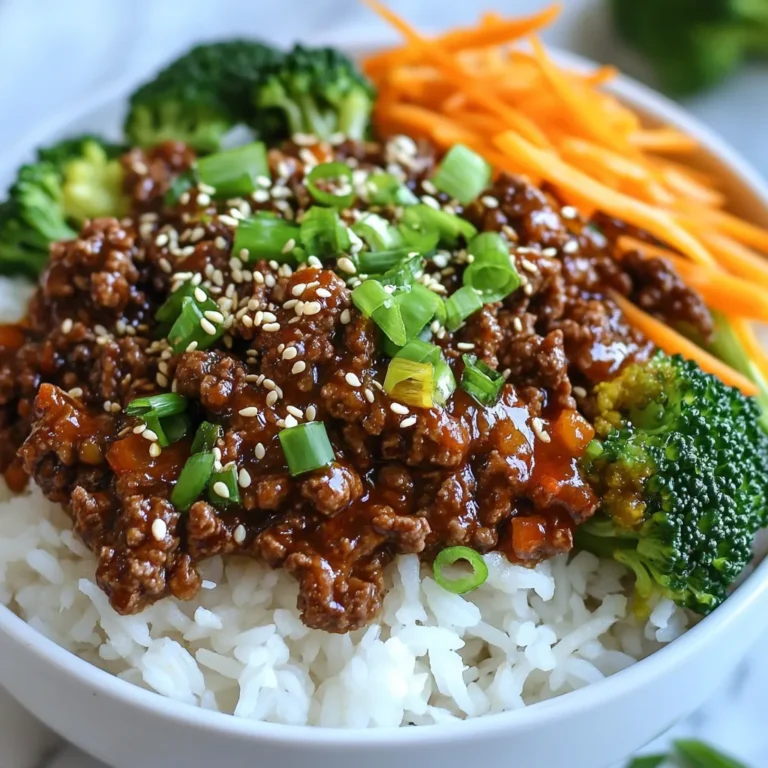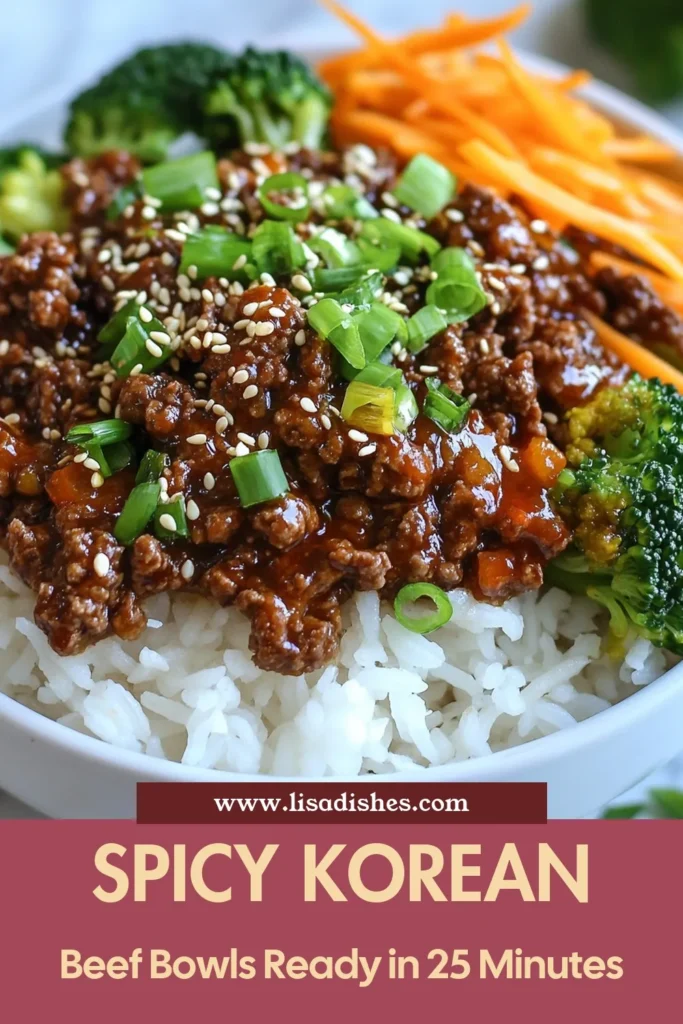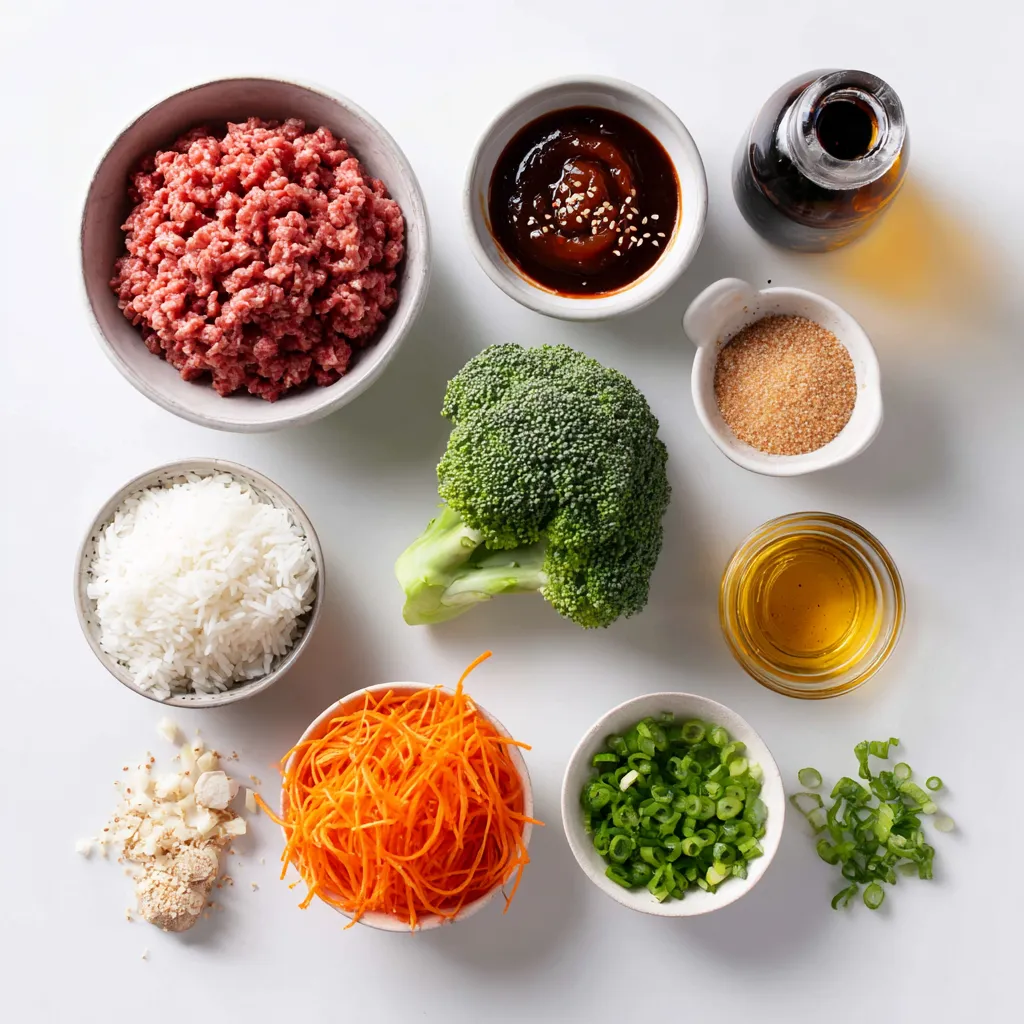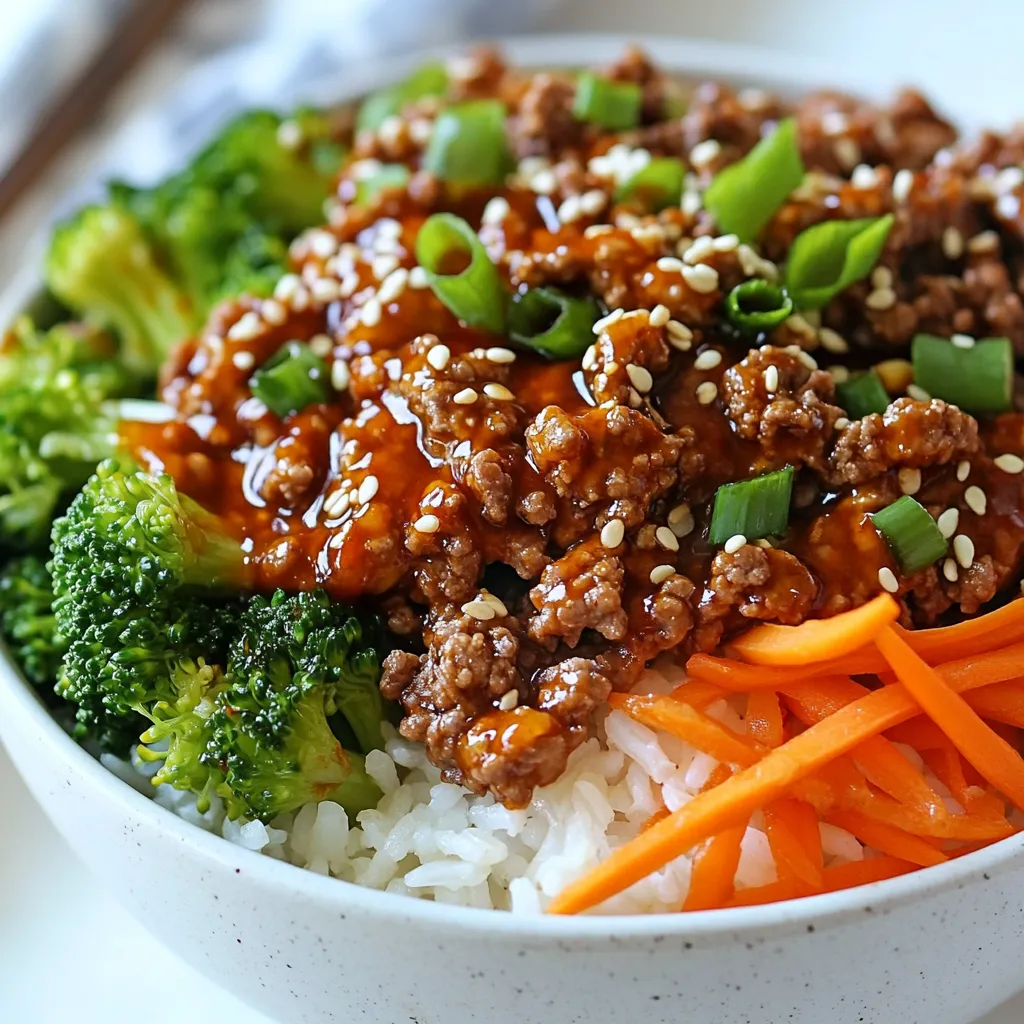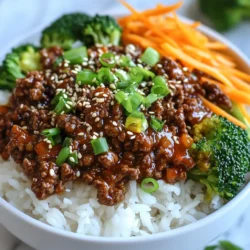WANT TO SAVE THIS RECIPE?
Get ready to spice up your dinner routine with my bold and flavorful Spicy Korean Beef Bowls recipe! I’ll walk you through easy ingredients and fun cooking steps, ensuring a delicious meal every time. Whether you want to customize it or learn some great tips, I’ve got you covered. Join me on this tasty adventure and surprise your taste buds with a dish that’s simple but packed with flavor!
Why I Love This Recipe
- Bold Flavors: The combination of gochujang, garlic, and ginger creates a vibrant and spicy flavor profile that truly excites the palate.
- Quick and Easy: With a total prep and cooking time of just 25 minutes, this recipe is perfect for busy weeknights when you need a delicious meal fast.
- Customizable: You can easily switch out the vegetables or protein to suit your tastes or dietary needs, making it a versatile option for any meal.
- Healthy Ingredients: Packed with lean protein and fresh veggies, this dish is both satisfying and nutritious, making it a great choice for a balanced meal.
Ingredients
Main Ingredients for Spicy Korean Beef Bowls
For this tasty dish, you need:
– 1 lb ground beef (or thinly sliced beef)
– 3 tablespoons gochujang (Korean chili paste)
– 2 tablespoons soy sauce
– 1 tablespoon sesame oil
– 1 tablespoon brown sugar
– 2 garlic cloves, minced
– 1-inch piece ginger, grated
– 1 cup cooked white rice (or cauliflower rice)
– 1 cup broccoli florets
– 1 carrot, julienned
– 2 green onions, chopped
– Toasted sesame seeds for garnish
These ingredients blend perfectly to create a spicy, savory flavor. Gochujang gives the dish its heat. The sesame oil adds a nice nutty taste.
Optional Ingredients for Customization
You can change this dish to fit your taste by adding:
– Bell peppers
– Spinach
– Mushrooms
– Kimchi
– Avocado
Feel free to mix and match. These additions can give your bowl new flavors and textures.
Substitutions for Common Allergens
If you have allergies, try these swaps:
– Use tamari instead of soy sauce for a gluten-free option.
– Replace sesame oil with olive oil if you are allergic to sesame.
– Try turkey or chicken instead of beef for a leaner choice.
These swaps keep the dish similar while making it safer for you. Enjoy cooking!

Step-by-Step Instructions
Prepping the Ingredients
First, gather all your ingredients. You need ground beef, gochujang, soy sauce, and sesame oil. Don’t forget brown sugar, garlic, and ginger. You will also need cooked rice, broccoli, carrot, and green onions. For garnish, get toasted sesame seeds. Make sure to wash and chop the vegetables. Julienning the carrot makes it cook faster and look nice.
Cooking the Beef
Start by heating the sesame oil in a large skillet over medium heat. Add the minced garlic and grated ginger. Sauté them for about 30 seconds. This step brings out their flavor. Next, add the ground beef or sliced beef to the skillet. Cook it until it turns brown. Use a wooden spoon to break the meat apart. This should take about 5 to 7 minutes.
Now, mix gochujang, soy sauce, and brown sugar in a small bowl. Pour this mix over the beef in the skillet. Stir well to coat the meat. Cook for an additional 2 to 3 minutes. This step helps the flavors blend together.
Assembling the Bowl
While the beef cooks, steam the broccoli and carrot until they are tender-crisp. This takes about 4 to 5 minutes. You can steam them on the stovetop or microwave.
Now it’s time to put everything together. Start with a scoop of cooked rice at the bottom of your bowl. Then, add the spicy beef on top. Follow with the steamed broccoli and carrot. Finally, garnish with chopped green onions and a sprinkle of toasted sesame seeds. Serve your spicy Korean beef bowls hot for the best taste.
Tips & Tricks
Perfecting Your Spicy Korean Beef
To make your spicy Korean beef truly shine, use fresh ingredients. Fresh garlic and ginger add a punch to the dish. When cooking, heat the sesame oil first. This step wakes up the flavors in the oil. Mix the gochujang, soy sauce, and brown sugar well. This blend gives the beef a nice glaze. Cook the beef until it is browned. This will enhance the flavor and texture.
Cooking Tips for Perfectly Steamed Vegetables
Steaming your veggies keeps them bright and crunchy. Use a stovetop steamer or a microwave-safe bowl. If using the microwave, cover the bowl with a lid or plastic wrap. This traps steam and cooks the veggies quickly. Steam broccoli and carrots for about 4-5 minutes. Check if they are tender-crisp. You want them to maintain some bite.
Serving Suggestions for an Authentic Experience
For a true Korean feel, use a bowl for serving. Start with a scoop of rice at the bottom. Add the spicy beef and then top with the steamed veggies. Scatter green onions and toasted sesame seeds on top. This adds color and texture. Serve hot for the best experience. Enjoy your meal with chopsticks for added fun!
Pro Tips
- Choose the Right Beef: For a more tender and flavorful dish, opt for thinly sliced ribeye or sirloin instead of ground beef.
- Adjust the Spice Level: If you prefer a milder flavor, reduce the amount of gochujang. You can also add more sugar to balance the heat.
- Prep Your Veggies Ahead: Cut and prep your vegetables in advance to save time during cooking and ensure everything is fresh.
- Serve with Fresh Herbs: Add fresh cilantro or mint as a garnish for an extra layer of flavor and a pop of color.

Variations
Vegetarian and Vegan Adaptations
You can easily make this dish vegetarian or vegan. Replace the ground beef with plant-based meat. Options like lentils or mushrooms work well too. For a vegan version, swap regular soy sauce for a gluten-free one. Use coconut sugar instead of brown sugar for sweetness. Add tofu for protein and texture, and you’ll have a delicious bowl.
Low-Carb Options with Cauliflower Rice
If you want a low-carb meal, use cauliflower rice instead of white rice. It adds a nice texture and cuts down on carbs. Just pulse cauliflower florets in a food processor until they look like rice. Then, lightly sauté it in sesame oil for extra flavor. It makes a healthy base for your spicy beef.
Spicy Additions for Heat Lovers
For those who crave more heat, you can add extra gochujang. Try mixing in red pepper flakes or fresh chili slices. Toss in spicy kimchi for added flavor and crunch. You can also serve with a drizzle of sriracha on top. Each option ramps up the spice and makes your bowl even more exciting.
Storage Info
How to Store Leftovers
Store your spicy Korean beef bowls in an airtight container. Let the dish cool before sealing. Keep it in the fridge for up to three days. If you want to save it longer, try freezing.
Reheating Tips for Optimal Flavor
To reheat, use the microwave or a skillet. For the microwave, heat for about 1-2 minutes. Stir halfway through for even warmth. If using a skillet, add a splash of water or broth. Heat on low until warmed through. This helps keep the beef juicy.
Freezing Guidance for Meal Prep
If you want to freeze, pack the beef and veggies separately from the rice. This way, the rice won’t get mushy when thawed. Use freezer-safe containers or bags. Label them with the date. You can freeze for up to three months. When ready to eat, thaw overnight in the fridge. Reheat as mentioned above.
FAQs
What is Gochujang and Where Can I Find It?
Gochujang is a red chili paste from Korea. It has a sweet and spicy flavor. You can find it in Asian grocery stores. Many large supermarkets also carry it. Look in the international aisle or the Asian section. It comes in a tub or squeeze bottle.
Can I Use Different Proteins in This Recipe?
Yes, you can use other proteins. Ground turkey or chicken works well. Thinly sliced beef is great too. For a vegetarian option, use tofu or tempeh. Just make sure to adjust the cooking time for each protein.
How Spicy is Spicy Korean Beef Bowls?
These bowls are spicy but not overwhelming. Gochujang gives them heat and flavor. If you want less spice, use less gochujang. You can also add more sugar to balance the heat. Adjust it to fit your taste.
What are Some Traditional Sides to Serve with this Dish?
Some great sides are kimchi, pickled radishes, or steamed dumplings. You can also serve it with a simple salad. Rice is a common side, too. All these sides complement the bold flavors of the beef bowl perfectly.
In this blog post, we explored how to make flavorful Spicy Korean Beef Bowls. We covered key ingredients, cooking steps, and tips for the perfect dish. Customization and variety allow you to meet different tastes and diets. Storing and reheating tips make it easy to enjoy leftovers. Whether you stick to beef or try vegan options, you can create a meal everyone will love. Enjoy your cooking journey and make this dish your ow
Spicy Korean Beef Bowls
A flavorful and spicy dish featuring ground beef, gochujang, and fresh vegetables served over rice.
Prep Time 10 minutes mins
Cook Time 15 minutes mins
Total Time 25 minutes mins
Course Main Course
Cuisine Korean
Servings 4
Calories 450 kcal
- 1 lb ground beef (or thinly sliced beef)
- 3 tablespoons gochujang (Korean chili paste)
- 2 tablespoons soy sauce
- 1 tablespoon sesame oil
- 1 tablespoon brown sugar
- 2 cloves garlic, minced
- 1 inch piece ginger, grated
- 1 cup cooked white rice (or cauliflower rice)
- 1 cup broccoli florets
- 1 carrot julienned
- 2 green onions chopped
- to taste toasted sesame seeds for garnish
In a large skillet, heat the sesame oil over medium heat. Add the minced garlic and grated ginger, sautéing for about 30 seconds until fragrant.
Add the ground beef (or sliced beef) to the skillet. Cook until browned and fully cooked through, breaking it apart with a wooden spoon as it cooks, about 5-7 minutes.
In a small bowl, mix together gochujang, soy sauce, and brown sugar. Pour this mixture over the beef in the skillet. Stir to coat the meat evenly and cook for an additional 2-3 minutes until heated through.
Meanwhile, steam the broccoli and carrot until they are tender-crisp. This should take about 4-5 minutes. You can do this in a stovetop steamer or in the microwave.
To assemble the bowl, place a generous scoop of cooked rice at the bottom. Top with the spicy beef, steamed broccoli, and carrot.
Garnish with chopped green onions and a sprinkle of toasted sesame seeds. Serve hot.
You can substitute cauliflower rice for a low-carb option.
Keyword beef, korean, quick meal, rice, spicy
WANT TO SAVE THIS RECIPE?
